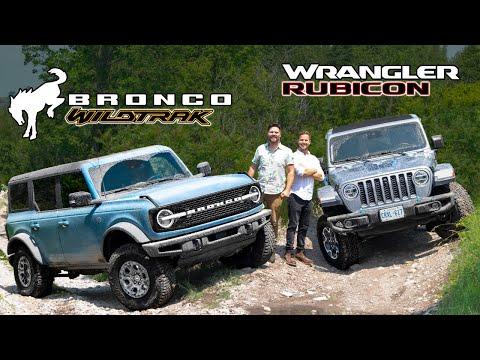I remember the day vividly, a perfect blend of excitement and trepidation as I prepared for an off-road showdown between two iconic vehicles: the 2021 Ford Bronco Wildtrak and the Jeep Wrangler Rubicon. Both are legends in their own right, celebrated for their off-road capabilities and rugged design, but I wanted to see firsthand how they compared when pushed to their limits.
The sun was just beginning to rise, casting a golden hue over the rugged terrain we were about to tackle. The mountains loomed in the distance, their peaks veiled in a soft mist, hinting at the challenges that lay ahead. I had spent weeks researching and planning this test, poring over specifications, user reviews, and off-road performance data. But nothing could compare to experiencing these vehicles up close and personal.
The 2021 Ford Bronco Wildtrak had been generating a lot of buzz. With its aggressive styling and a plethora of off-road features, it seemed like a worthy competitor. I’d seen the promotional videos, and the Wildtrak looked like it was ready to conquer anything in its path. On the other hand, the Jeep Wrangler Rubicon was a seasoned veteran. The Rubicon has been a benchmark for off-road prowess for decades, so it was only fitting that it would be the Bronco’s challenger.
I got behind the wheel of the Bronco first. The moment I started the engine, I was greeted by a throaty growl that hinted at the Wildtrak’s potential. The interior was a blend of modern technology and rugged design, with plenty of buttons and dials for off-road controls. The Bronco’s suspension felt solid and well-tuned as we started our ascent into the hills. It handled the rough terrain with impressive stability, and the 35-inch tires gripped the rocky path with ease.
What struck me most about the Wildtrak was its advanced Terrain Management System. With seven G.O.A.T. (Go Over Any Terrain) Modes, I could tailor the vehicle’s performance to suit the ever-changing landscape. Switching to Baja mode, the Bronco roared as it powered over the dunes, effortlessly gliding over obstacles. The electronic locking rear differential and sway bar disconnect provided the extra edge needed to handle the more technical sections of the trail.
As we pushed deeper into the trail, the Bronco continued to impress. The high ground clearance and short front and rear overhangs allowed it to approach and descend steep grades without hesitation. The visibility was excellent, thanks to the high driving position and the Bronco’s large windows, giving me a clear view of the trail ahead. The Bronco’s off-road cameras provided a 360-degree view, making it easier to navigate tight spots and tricky obstacles.
After a couple of hours of testing the Bronco, it was time to switch to the Jeep Wrangler Rubicon. The transition from the Bronco to the Wrangler was stark but familiar. The Rubicon had a more utilitarian feel, with its exposed bolts and rugged materials. The interior was simpler, but it was clear that it was designed with off-road durability in mind.
Starting the Rubicon’s engine, I immediately felt the characteristic Jeep growl, a sound that’s become synonymous with off-road adventure. As I took it through the same rugged trails, the Wrangler’s performance was nothing short of stellar. The solid axles and legendary 4×4 system made short work of the rough terrain. The Rubicon’s crawl ratio was exceptional, allowing it to crawl over boulders and steep inclines with minimal throttle input.
One of the Wrangler’s standout features was its manual transmission, which provided a level of control that I hadn’t experienced with the Bronco. The manual gearbox allowed me to precisely modulate power and tackle obstacles with a finesse that the automatic transmission in the Bronco couldn’t match. The Rubicon’s electronic locking differentials and sway bar disconnects were also incredibly effective, giving it a remarkable ability to maintain traction and stability.
Comparing the two vehicles, it was clear that both had their strengths. The Bronco Wildtrak excelled in technology and comfort, with its sophisticated off-road systems and modern amenities making it a pleasure to drive on and off the road. Its approach to off-roading was more refined, with advanced features that helped it handle various terrains with ease. On the other hand, the Jeep Wrangler Rubicon was a testament to classic off-road engineering. Its robust build, manual transmission, and tried-and-true off-road systems made it feel like a trusty companion on the toughest trails.
As the day came to a close, I was left with a deep appreciation for both vehicles. The Bronco Wildtrak was a modern marvel, bringing high-tech sophistication to the off-road world, while the Jeep Wrangler Rubicon remained a stalwart of rugged reliability. Choosing between them ultimately came down to personal preference and the type of adventure one sought. The Bronco offered a more refined, tech-savvy approach to off-roading, whereas the Wrangler provided a raw, unfiltered connection to the trail.
Reflecting on the test, I realized that both the Ford Bronco Wildtrak and the Jeep Wrangler Rubicon had their unique charms and capabilities. Each vehicle brought something special to the table, making it a tough decision for any off-road enthusiast. For me, the experience was a reminder of why I fell in love with off-roading in the first place: the thrill of exploring new terrains, the joy of mastering challenging trails, and the satisfaction of finding the perfect vehicle for the journey.
